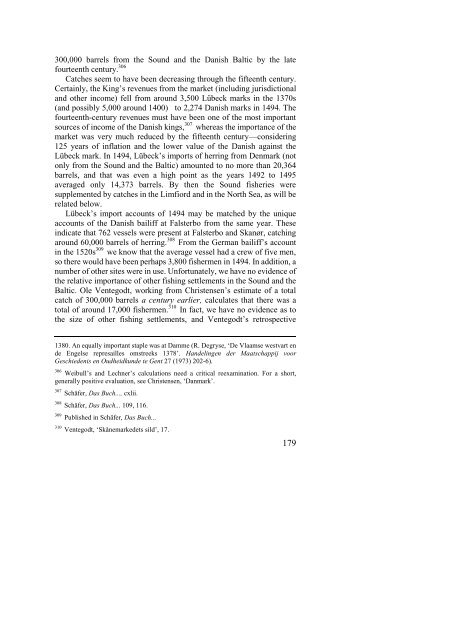The North Atlantic Fisheries, 1100-1976 - University of Hull
The North Atlantic Fisheries, 1100-1976 - University of Hull
The North Atlantic Fisheries, 1100-1976 - University of Hull
You also want an ePaper? Increase the reach of your titles
YUMPU automatically turns print PDFs into web optimized ePapers that Google loves.
300,000 barrels from the Sound and the Danish Baltic by the late<br />
fourteenth century. 306<br />
Catches seem to have been decreasing through the fifteenth century.<br />
Certainly, the King’s revenues from the market (including jurisdictional<br />
and other income) fell from around 3,500 Lübeck marks in the 1370s<br />
(and possibly 5,000 around 1400) to 2,274 Danish marks in 1494. <strong>The</strong><br />
fourteenth-century revenues must have been one <strong>of</strong> the most important<br />
sources <strong>of</strong> income <strong>of</strong> the Danish kings, 307 whereas the importance <strong>of</strong> the<br />
market was very much reduced by the fifteenth century—considering<br />
125 years <strong>of</strong> inflation and the lower value <strong>of</strong> the Danish against the<br />
Lübeck mark. In 1494, Lübeck’s imports <strong>of</strong> herring from Denmark (not<br />
only from the Sound and the Baltic) amounted to no more than 20,364<br />
barrels, and that was even a high point as the years 1492 to 1495<br />
averaged only 14,373 barrels. By then the Sound fisheries were<br />
supplemented by catches in the Limfiord and in the <strong>North</strong> Sea, as will be<br />
related below.<br />
Lübeck’s import accounts <strong>of</strong> 1494 may be matched by the unique<br />
accounts <strong>of</strong> the Danish bailiff at Falsterbo from the same year. <strong>The</strong>se<br />
indicate that 762 vessels were present at Falsterbo and Skanør, catching<br />
around 60,000 barrels <strong>of</strong> herring. 308 From the German bailiff’s account<br />
in the 1520s 309 we know that the average vessel had a crew <strong>of</strong> five men,<br />
so there would have been perhaps 3,800 fishermen in 1494. In addition, a<br />
number <strong>of</strong> other sites were in use. Unfortunately, we have no evidence <strong>of</strong><br />
the relative importance <strong>of</strong> other fishing settlements in the Sound and the<br />
Baltic. Ole Ventegodt, working from Christensen’s estimate <strong>of</strong> a total<br />
catch <strong>of</strong> 300,000 barrels a century earlier, calculates that there was a<br />
total <strong>of</strong> around 17,000 fishermen. 310 In fact, we have no evidence as to<br />
the size <strong>of</strong> other fishing settlements, and Ventegodt’s retrospective<br />
1380. An equally important staple was at Damme (R. Degryse, ‘De Vlaamse westvart en<br />
de Engelse represailles omstreeks 1378’. Handelingen der Maatschappij voor<br />
Geschiedenis en Oudheidkunde te Gent 27 (1973) 202-6).<br />
306 Weibull’s and Lechner’s calculations need a critical reexamination. For a short,<br />
generally positive evaluation, see Christensen, ‘Danmark’.<br />
307 Schäfer, Das Buch..., cxlii.<br />
308 Schäfer, Das Buch... 109, 116.<br />
309 Published in Schäfer, Das Buch...<br />
310 Ventegodt, ‘Skånemarkedets sild’, 17.<br />
179















